Drilling and blasting, commonly referred to as "drill and blast," is a powerful and widely used technique in industries like mining, quarrying, and construction. This method involves strategically drilling holes into the rock and using explosives to break it into manageable chunks. While it sounds simple, this process demands extensive expertise, meticulous planning, and strict safety protocols.
This article will take you deep into the world of drilling and blasting, exploring its applications, processes, and the pivotal role it plays across various industries. We’ll cover everything from the initial drilling phase to the final explosion, giving you a comprehensive understanding of this dynamic process.
What is Drilling and Blasting?
Drilling and blasting (DBM) is a controlled method used to break rock for excavation purposes. It’s a tried-and-true technique utilized in many applications, including:
- Mining: Extracting valuable minerals and ores.
- Quarrying: Obtaining stone and other building materials.
- Civil Engineering: Constructing tunnels, roads, dams, and other infrastructure projects.
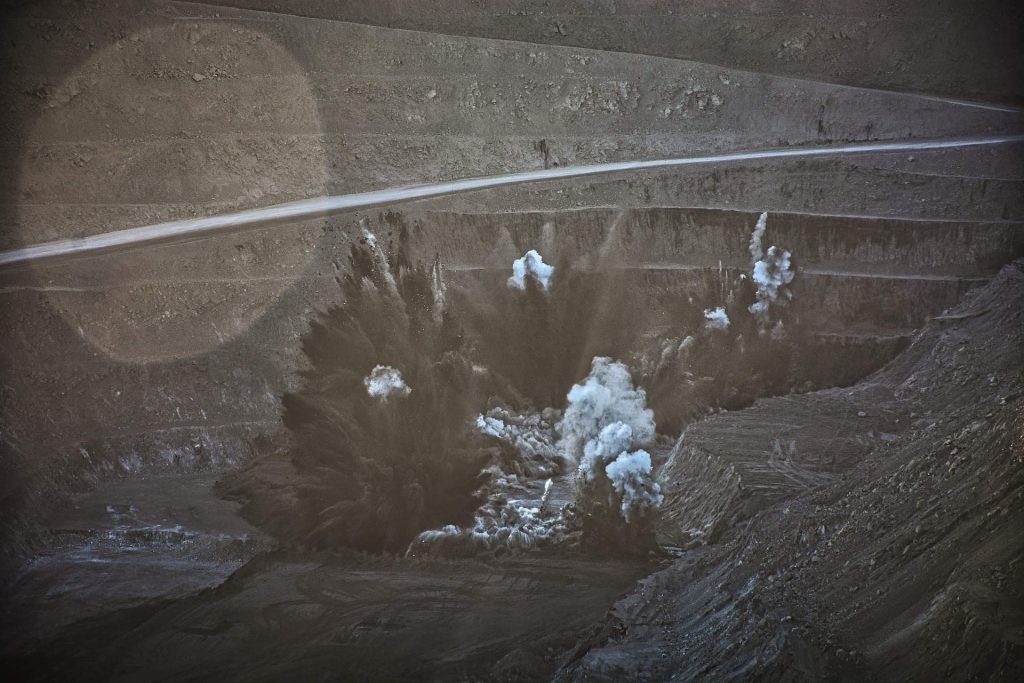
What is the Process of Drilling and Blasting?
The standard drilling and blasting cycle consists of a series of well-defined steps to ensure safety, efficiency, and effective rock fragmentation.
1. Drilling
Specialized mobile platforms called jumbos dominate the initial drilling phase. These machines have three powerful manipulators acting as drilling arms and a central operator console for precise control. Jumbos usually connect to an electrical grid for power.
A critical component is the high-pressure water supply feeding pneumatic drifters. This water helps the drill bits rotate and hammer the rock face, creating cylindrical cavities (boreholes) ranging from 2.4 to 3.6 meters in length.
The number, depth, and orientation of these boreholes are carefully planned based on the desired fragmentation outcome for efficient rock removal and the need for geotechnical stability to ensure the integrity of the surrounding rock mass.
The configuration of the boreholes, known as the drilling pattern, plays a crucial role. Common patterns include:
- Square Pattern: Offers equal spacing and burden (distance between boreholes and the rock face) with rows aligned directly behind each other.
- Rectangular Pattern: Similar to the square pattern, but with a larger spacing between boreholes compared to the burden.
- Staggered Pattern: Boreholes in each row are offset, creating a honeycomb-like pattern. This optimizes fragmentation while minimizing burden.
- Equilateral Triangle Pattern: Similar to the staggered pattern, but with a specific spacing-to-burden ratio for efficient rock breakage.
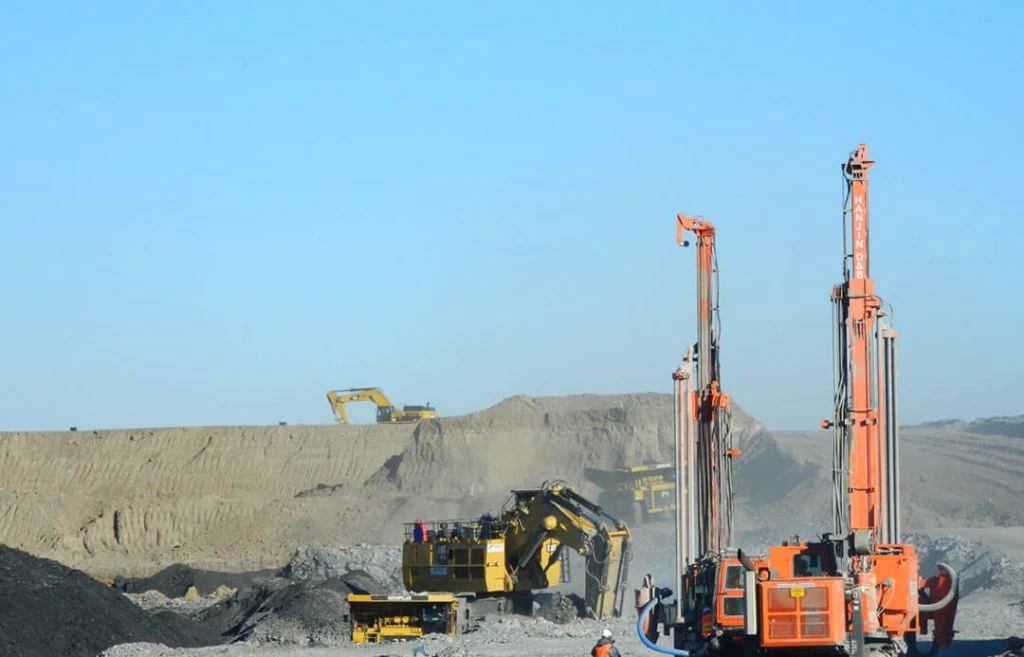
2. Explosive Charging
Once drilling is complete, it's time to load the boreholes with explosives. The type of explosive chosen depends on the rock's characteristics. Common options include:
- Dynamite Variations: Traditional dynamite is still used in some cases, but it's often replaced by safer and more controllable options like ammonium nitrate fuel oil (ANFO) mixtures.
- Water Gels: These gel-like explosives are popular due to their water resistance, making them suitable for wet environments. They also tend to produce fewer fumes compared to traditional dynamite.
- Emulsions: Water-in-oil emulsions offer good blasting performance and are less sensitive to shock and fire compared to other explosives.
To minimize the risks associated with explosives, mechanized charging equipment is extensively used. This ensures the safe and controlled placement of the explosive materials within the boreholes.
Detonators are attached to each explosive device and subsequently interconnected to form a predetermined blasting sequence. Civil and structural engineers leverage advanced telemetry systems to monitor potentially hazardous areas during this crucial stage, further strengthening safety measures.
3. Blasting
Controlled blasting, a common technique that minimizes overbreak (excess rock breakage) and ground vibrations, ensures clean excavations and protects surrounding structures from damaging tremors.
- Pre-Splitting: Creates a clean fracture plane using a single row of precisely placed and detonated holes, minimizing overbreak in the main blast.
- Smooth Blasting: Used in underground mines, this method involves detonating lightly charged holes along the final excavation line after the main blast, creating a smooth and stable wall with minimal overbreak.
- Cushion Blasting: Similar to smooth blasting, the holes are backfilled with crushed rock to absorb the shockwave and further minimize damage to the final wall.
Detonation order is crucial. Blasts are carefully sequenced, typically starting from the center and moving outwards. This ensures optimal rock fragmentation while minimizing vibrations. Precise timing between detonations further refines control, focusing the energy release.

4. Ventilation
Explosions generate significant dust clouds mixed with combustion gases. Ventilation becomes essential to ensure worker safety and a healthy working environment.
Long steel or plastic pipes are used as air ducts. These are often attached to the tunnel's roof and strategically positioned to blow fresh air onto the working face, effectively removing dust and fumes.
Mucking and Scaling
After blasting, the fragmented rock, referred to as muck, needs to be removed. This process involves loading the broken rock into hauling vehicles like dump trucks and transporting it out of the excavation area.
Following the initial clearance, a process called scaling is crucial. This involves removing any loose pieces of rock from the crown (ceiling) and walls to prevent potential rockfalls and ensure worker safety.
Ground Support Installation
As the tunnel excavation progresses, the newly exposed ceiling and side walls require support to prevent rock falls and ensure tunnel stability.
Several methods are employed for ground support, depending on the specific site conditions. Common options include:
- Rock bolts or dowels: These are long, slender steel bars drilled into the rock and secured with a mechanical wedge or adhesive to reinforce the rock mass.
- Shotcrete: A layer of sprayed concrete is applied directly to the rock surface to provide immediate support and strengthen the surrounding rock mass.
- Ribs or mining arches and lagging: These are prefabricated steel frames used to create a temporary support structure within the tunnel.
- Cable bolts: High-strength cables are grouted into boreholes and anchored behind the rock face to provide additional support and reinforcement.
- In-situ concrete: This technique involves casting concrete within the excavated space to create a permanent and robust tunnel lining.
Drilling and Blasting vs. Tunnel Boring Machines (TBM)
Building tunnels is a crucial aspect of modern infrastructure development. When it comes to creating these underground pathways, two main methods dominate the scene: Drilling and Blasting and Tunnel Boring Machines (TBM). Each method offers distinct advantages and limitations, making a well-informed choice vital for project success.
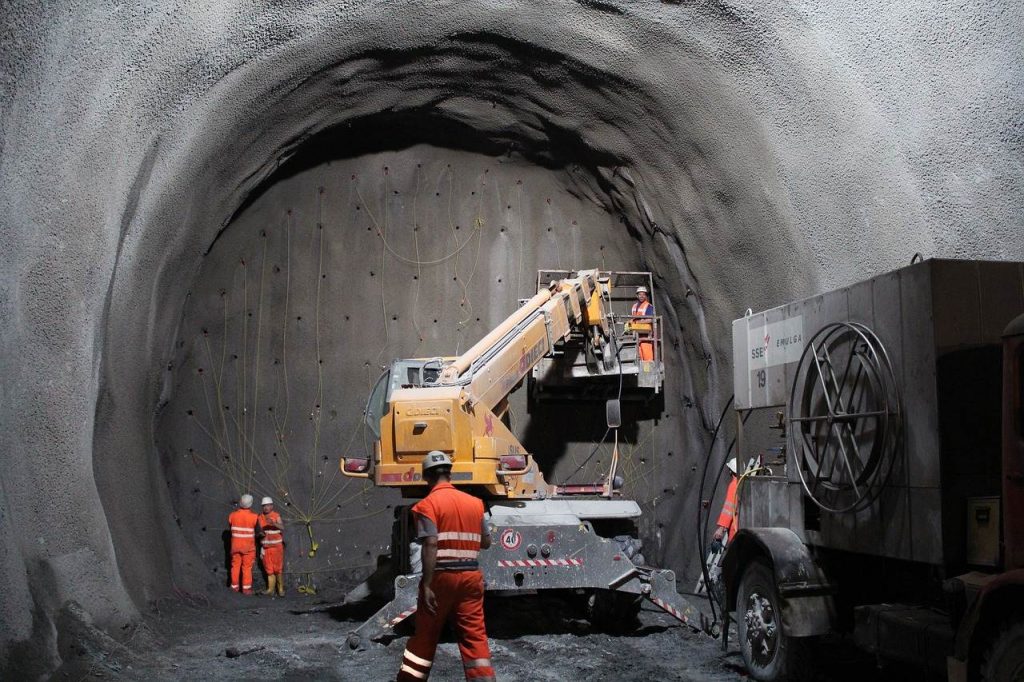
Drilling and Blasting
Drilling and blasting involves meticulously drilling holes into the rock face, strategically placing explosives, and detonating them in a controlled manner to break the rock. The fragmented material is then removed.
Advantages:
- Adaptability: The drill and blast method excels in tackling various tunnel shapes and sizes, making it suitable for complex geometries and changing diameters.
- Unforeseen Conditions: It adapts well to unexpected geological surprises encountered during excavation.
- Cost-Effective: Drilling and blasting often require a lower initial investment compared to TBMs.
Disadvantages:
- Speed: The Drill & Blast technique's progress can be slower due to the repetitive cycle of drilling, blasting, and muck removal.
- Overbreak: The blasting process can cause fractures beyond the intended excavation line, leading to wasted material and requiring additional support measures.
- Environmental Impact: Vibrations and dust generated during blasting pose challenges in populated areas.
- Safety: The Drill & Blast method inherently involves handling explosives, demanding highly skilled personnel and stringent safety protocols.
Tunnel Boring Machines (TBM)
TBMs are colossal machines equipped with rotating cutting heads that grind and shear the rock face. The excavated material is continuously removed on a conveyor belt.
Advantages:
- Speed: TBMs boast impressive excavation rates, especially in good rock conditions, significantly reducing project timelines.
- Precision: TBMs deliver a smooth, near-perfect tunnel profile, minimizing overbreak and the need for additional support.
- Environmental Impact: TBMs generate less vibration and dust compared to the drill and blast method, making them ideal for urban environments.
- Safety: A large portion of the excavation occurs within the controlled TBM environment, enhancing worker safety.
Disadvantages:
- Flexibility: TBMs are primarily designed for circular tunnels with consistent diameters. Complex shapes or changing diameters can be challenging.
- Cost: The initial investment in acquiring and operating a TBM is significantly higher than drilling and blasting.
- Ground Conditions: TBMs perform best in stable and predictable rock formations.

Making the Right Choice:
Selecting the optimal method hinges on several crucial factors:
- Project Size and Shape: The drill and blast method is better suited for shorter tunnels and non-uniform shapes, while TBMs excel in longer, circular tunnels.
- Rock Conditions: Stable rock formations favor TBMs, while drill and blast can adapt better to unforeseen geological variations.
- Environmental Constraints: In populated areas, TBMs are preferred due to their lower environmental impact.
- Budget: Drilling and blasting techniques often have a lower upfront cost, while TBMs might require a higher initial investment but can potentially recoup the cost through faster completion times.
Challenges of Traditional Drilling and Blasting
In today's competitive construction and mining landscape, efficiency and safety are paramount. However, traditional drilling and blasting methods can introduce hidden delays and significant safety risks, impacting project timelines and worker well-being. Let’s delve into the key challenges:
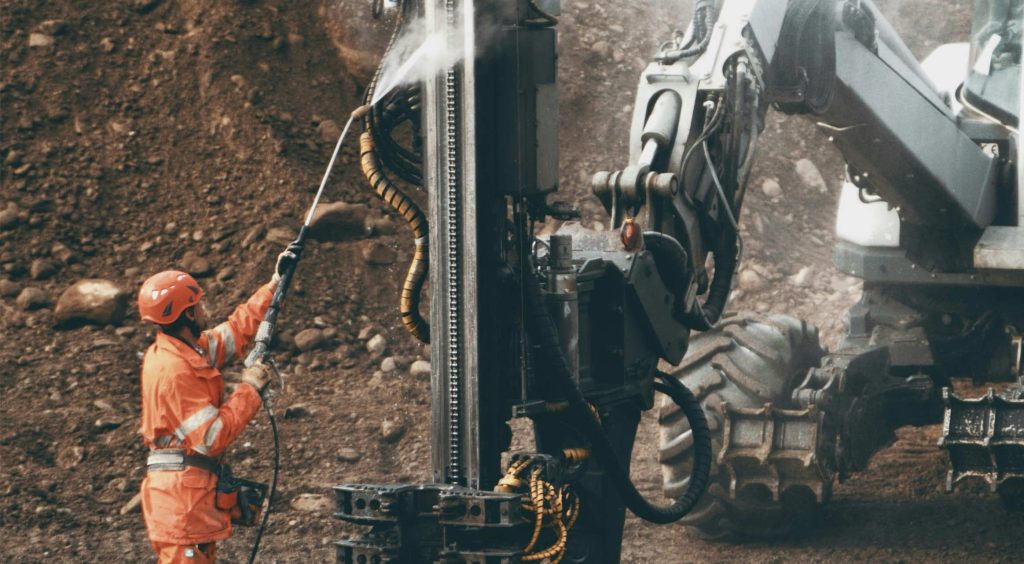
Blind Spots and Breakdowns
Blasting inherently carries the risk of flying debris (flyrock), ground vibrations, and toxic fumes. Strict adherence to safety protocols, including proper blast design, exclusion zone management, and misfire prevention, is paramount.
However, human observation alone has limitations in identifying all potential hazards. Visual inspections may miss hidden pockets of gas trapped within the rock face, which can lead to dangerous explosions.
Relying solely on line-of-sight observation for exclusion zone clearance can leave personnel vulnerable to flyrock ejected from the blast.
Additionally, traditional methods for verifying blast design accuracy often involve manual calculations and paper-based workflows, which are prone to human error.
Reactive Monitoring and Incomplete Data
Traditional monitoring methods often involve collecting data after the blast, such as fragmentation size (rock size after blasting) and blast vibration levels. This approach is time-consuming and reactive.
Identifying issues like improper detonation timing, misfires, or incomplete fragmentation after detonation can lead to delays in subsequent blasting rounds and require costly rework.
Additionally, relying on static vibration monitoring stations positioned at specific locations may not capture the full impact of ground vibrations on nearby structures or communities.
Downtime Dilemmas and Inefficient Fragmentation
Safety protocols necessitate clearing the blast zone of all personnel and equipment before detonation. This creates downtime and impacts efficiency.
Additionally, achieving optimal fragmentation size during blasting is crucial for efficient downstream processing in crushers and mills.
Traditional methods for assessing fragmentation rely on manual measurements after the blast, which can be inaccurate, slow, and prone to human error.
Limited Environmental Oversight and Community Concerns
Drilling and blasting can generate significant dust and noise pollution, potentially impacting nearby communities and violating environmental regulations.
Traditional methods of monitoring these factors often rely on static monitoring stations positioned at specific locations.
This approach may not capture the complete picture of dust dispersion or noise propagation throughout the blasting area.
Imagine a scenario where a blasting operation in a rural area generates unexpected dust plumes that travel further than anticipated, reaching a nearby town and causing health concerns for residents.
Static monitoring stations positioned at predetermined locations might miss this crucial information.
How Drones Revolutionize Drilling and Blasting?
Accurate, real-time data is the cornerstone of safe and efficient drilling and blasting operations. This is where drones come in—offering unparalleled precision by capturing detailed aerial imagery and enabling proactive, data-driven decision-making throughout the blasting process.
The JOUAV CW-25E VTOL Drone is a perfect solution, boasting a class-leading 240-minute flight time for extended missions, high-precision RTK and PPK capabilities, advanced safety features, and a 6 kg payload capacity with customizable options for cameras, thermal imaging, and sensors to meet any project requirement.
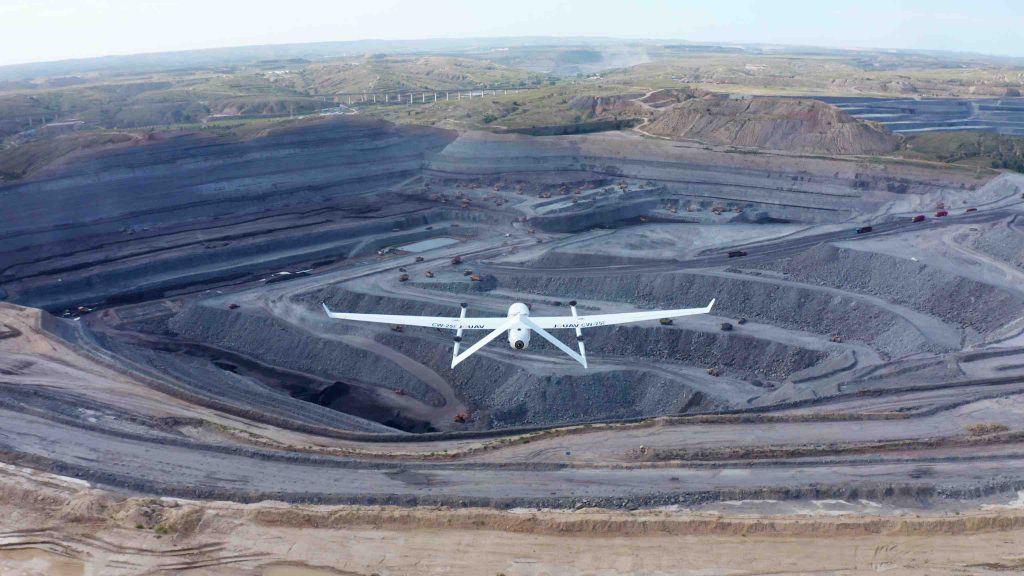
Let’s explore the specific applications of drones in drilling and blasting:
Enhanced Safety Through Remote Inspections
Drones equipped with high-resolution cameras and thermal imaging can be deployed remotely to conduct thorough inspections of drilling equipment in hazardous or hard-to-reach areas.
A thermal drone can detect overheating components before they fail, allowing for preventative maintenance and minimizing downtime.
Imagine a confined mine shaft: a drone can be sent in to inspect a drill head for wear and tear or abnormal heat signatures.
Early detection allows for timely repairs, preventing a major breakdown that could halt operations for days.
Pre-Blast Surveys and Design Optimization for Maximum Safety
Drones equipped with high-definition cameras provide a detailed aerial view for pre-blast surveys, surpassing human observation capabilities.
This allows for the identification of potential hazards like unstable rock formations, cracks, or voids, and misplaced explosives.
Additionally, specialized drone software can analyze the captured 3D point cloud data to identify potential flaws in the blast design or areas where the blast may not break as planned.
This comprehensive approach ensures operators are complying with safety protocols and minimizes the risk of accidents, protecting workers and surrounding infrastructure.

Real-Time Monitoring for Optimized Blast Performance
High-definition gimbal cameras on drones capture the blasting process from various angles, providing valuable real-time data.
This data can be analyzed to identify any issues with blast execution, such as improper detonation timing or misfires.
Blast vibration sensors mounted on drones capture real-time vibration data throughout the blast zone, allowing for immediate adjustments to future blasts to minimize environmental impact.
For example, analyzing post-blast footage may reveal improper fragmentation due to insufficient explosive placement.
This information can be used to refine the blast design, optimize blasting performance, and minimize the need for rework.
Faster Return to Work and Precise Fragmentation Analysis
Drones can be used to quickly and safely clear vast blast zones before detonation, eliminating the need for personnel to enter potentially hazardous areas.
Imagine a large open-pit mine: a drone efficiently clears the zone,
Sheet Metal Fabrication,Sheet Metal Plumbing,Sheet Metal Industrial,Steel Sheet Metal Fabrication
DONGGUAN TONJA INDUSTRIAL CO.LTD , https://www.tonjaism.com